Trying to decide between the .243 Winchester and 6.5 Creedmoor cartridges? Here’s what you need to know about them.
While the .243 Winchester has a long history of use as a great mild recoiling deer hunting cartridge, the 6.5 Creedmoor is much newer to the hunting game. Both offer certain advantages to hunters and there is a bit of overlap in their capabilities, but there are some significant differences between the 6.5 Creedmoor vs 243 Winchester cartridges you should be aware of.
Unfortunately, there’s a lot of hype and misinformation out there regarding the capabilities of these cartridges, especially with regards to the 6.5 Creedmoor. Not surprisingly, while each cartridge offers certain benefits to hunters, it’s still easy to get confused when trying to understand their actual strengths and weaknesses.
In this article, I’m going to do a detailed comparison of the 6.5 Creedmoor vs 243 Winchester and discuss the pros and cons of each one to help provide some insight into which cartridge will work best for you.
Before we get started, I have two administrative notes:
Some of the links below are affiliate links. This means I will earn a small commission (at no extra cost to you) if you make a purchase. This helps support the blog and allows me to continue to create free content that’s useful to hunters like yourself. Thanks for your support.
Additionally, I recorded an entire podcast episode on this exact subject. If you’d rather listen than read, click the appropriate link below to listen to this episode on your preferred podcasting player.
Be sure to hit that “Subscribe” button in your podcast player!
6.5 Creedmoor vs 243 Win Podcast
Apple | Google | iHeart | Pandora | Spotify
History Of The .243 Winchester & 6.5 Creedmoor
Just like the story of the 7mm-08 Remington and the 6.5 Creedmoor, the story of the .243 Winchester and the 6.5 Creedmoor really begins with the .308 Winchester.
Winchester unveiled the cartridge we now know as the .308 Winchester back in 1952 and the new cartridge quickly developed a reputation for accuracy, power, and efficiency with hunters and shooters. As is the case with many good cartridges, wildcatters and gun designers started modifying the .308 Winchester to develop new and more specialized wildcat cartridges almost immediately after it hit the market.
Among others, the .260 Remington, .338 Federal, and .358 Winchester are all descended from the legendary .308 Winchester as designers necked the case up or down as necessary to shoot smaller or larger 6.5mm, .33 caliber, or .35 caliber bullets respectively.
Experiments with necking down the .308 to shoot smaller, .243″ bullets yielded one of the first cartridges descended from the .308 Winchester in 1955: the .243 Winchester.
Similar to the difference between the .25-06 Remington and the .30-06 Springfield, by necking down the .308 case to shoot smaller caliber bullets, the designers of the .243 Winchester built a cartridge with a higher velocity, flatter trajectory, and less recoil than the .308 Winchester.
The new .243 Winchester really caught on with a segment of the hunting population that wanted a flat shooting and light recoiling rifle cartridge that was still powerful enough to hunt big game like deer and pronghorn. Capable of shooting heavy as well as light bullets with very good accuracy, the .243 Winchester was also a great varmint hunting cartridge and successfully bridged the gap between traditional varmint cartridges of the day like the .22 Hornet and popular big game hunting cartridges like the .30-06 Springfield.
While the .243 Winchester was indeed a very well designed and very effective cartridge, there are plenty of good cartridges that don’t experience commercial success for one reason or another. Fortunately for the .243 Winchester, Field & Stream editor Warren Page extolled the virtues of the .243 in his columns in a manner similar to what Jack O’Connor did for the .270 Winchester at Outdoor Life.
The efforts of Page certainly helped the .243 Winchester get established in the hunting and shooting communities. After all, a well designed cartridge that’s the subject of a good marketing campaign has much better odds of commercial success.
Well, the 6.5 Creedmoor is another good example of a great cartridge that received an enthusiastic and coordinated marketing campaign (from Hornady and Ruger in this case).
Unveiled in 2008, the 6.5 Creedmoor was the brainchild of Dave Emary and Dennis DeMille of Hornady Manufacturing. They designed the cartridge in an effort to gain an advantage in high power rifle competition shooting, which had been long dominated by the .308 Winchester. Basically, they wanted a new cartridge that could fit in a short action magazine and was just as accurate as the .308, but with less recoil, less wind drift, and a flatter trajectory.
By modifying a .30 Thompson Center (.30 TC) case to shoot .264″ bullets, they successfully built a cartridge with a relatively large case capacity optimized for use with 4350 class propellants that could also accommodate long, heavy, high ballistic coefficient (BC) bullets without intruding into the powder column.
Named the 6.5 Creedmoor (sometimes misspelled Creedmoore or Creedmore) in honor of the Creedmoor Matches and designed for use with a relatively fast 1:8″ rifling twist rate, Emary and DeMille were quite successful in their goal of building the ideal competition shooting cartridge.
A pretty representative 6.5 Creedmoor load shoots a 140 grain bullet at about 2,700 fps (2,266 ft-lbs). So, the 6.5 Creedmoor does not have eye popping ballistics, but it has moderate recoil, is very accurate, and uses high BC bullets that retain energy and resist wind drift exceptionally well.
Like the .243 Winchester, the new 6.5 Creedmoor cartridge had less recoil and a flatter trajectory than the .308 Winchester. For those reasons, the cartridge has seen a great deal of success in the hands of competition shooters and has recently made the jump into the mainstream hunting community.
If you’d like to learn more about how the .243 Winchester and the 6.5 Creedmoor compare to the .308 Winchester in more detail, read the articles below:
243 vs 7mm-08 vs 308 Winchester: Which Is Right For You?
6.5 Creedmoor vs 308 Winchester Debate Settled
243 vs 6.5 Creedmoor: Cartridge Sizes
You can see the similarities and differences between the 6.5 Creedmoor and the .243 Winchester in the photo below.
First, the two cartridges are very similar in size and use a rimless bottlenecked case.
The .243 Winchester and 6.5 Creedmoor are both designed for use in short-action rifles and have similar case lengths as well as overall lengths. Both cartridges also have the same .473″ rim diameter.
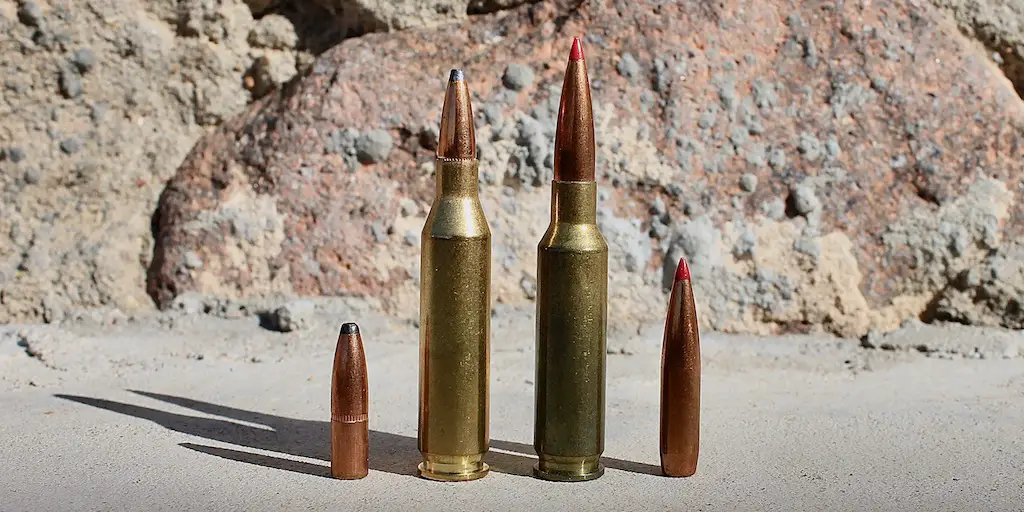
Bullet size is one of the most obvious differences between the 6.5 Creedmoor vs 243 Winchester though. Each cartridge uses different diameter bullets: .243″ (6mm) for the .243 Winchester and .264″ (6.5mm) for the Creedmoor.
There is also a significant difference in the most common bullet weights for each cartridge. The .243 Winchester cartridge most often uses bullet weights in the 55-115 grain range, with 55, 87, 90, and 100 grain bullets being the most common. On the other hand, the 6.5 Creedmoor most often utilizes bullet weights in the 95-160 grain range, with 120, 129, 140, and 143gr bullets being the most common.
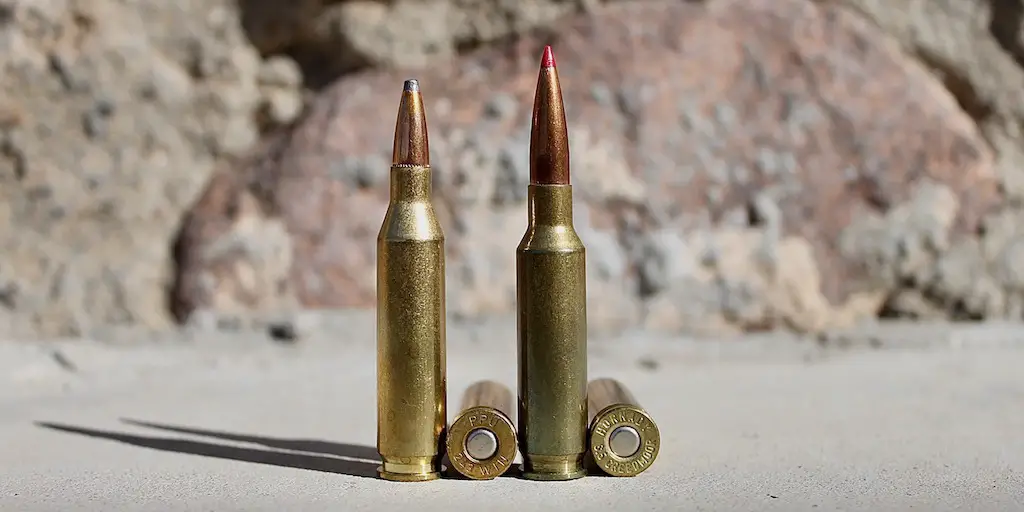
The 6.5 Creedmoor also has a slightly less tapered case with a steeper 30 degree shoulder (the .243 has a 20 degree shoulder). The end result is that, even though the 6.5 Creedmoor has a noticeably shorter case than the .243, the two cartridges have virtually the same case capacity.
The 6.5 Creedmoor is also loaded to a higher pressure than the .243 Winchester (62,000psi vs 60,000psi).
Note: while the powder capacity figures listed below do give a good indication of the differences between the two cartridges, exact case capacities vary slightly according to the brand of brass used.
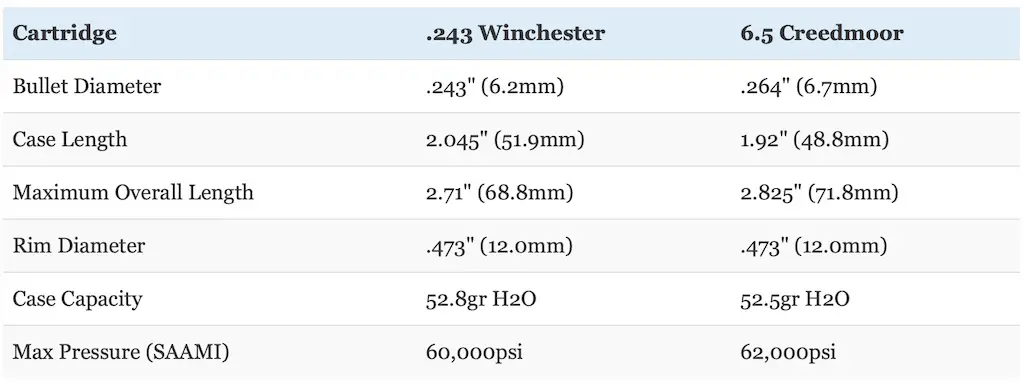
6.5 Creedmoor vs 243 Ballistics
The similarities and differences in the external dimensions of the .243 Winchester and 6.5 Creedmoor translate into some interesting differences in their ballistic performance.
This is illustrated in the table below comparing Hornady and Nosler factory ammunition. The .243 Winchester loads use a 90gr Ballistic Tip (.365 BC) and a 90gr ELD-X (.409 BC) while the 6.5 Creedmoor loads use a 140gr Ballistic Tip (.509 BC) and a 143gr ELD-X (.625 BC).
All four loads used a 200 yard zero.
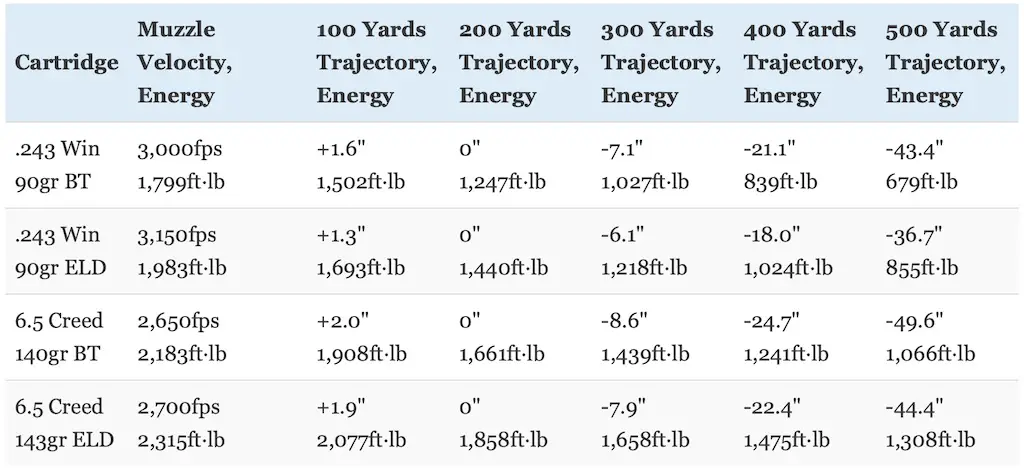
As you can see, the .243 Winchester pushes those lighter bullets at a significantly faster muzzle velocity than the 6.5 Creedmoor. That 300-500 fps advantage in muzzle velocity translates into a flatter trajectory with less bullet drop at longer range.
However, both of the 6.5 Creedmoor loads each use a heavier and more aerodynamic bullet with a higher ballistic coefficient. So, the Creedmoor has more kinetic energy at all ranges and that gap significantly increases in size as range increases.
With these particular loads, the 6.5 Creedmoor has approximately 10-30% more muzzle energy than the .243 Winchester. That turns into a 25-95% advantage in favor of 6.5 Creedmoor at 500 yards.
So, I think it’s fair to say that the 6.5 Creedmoor hits significantly harder than the .243 Winchester, especially at longer range.
The chart below compares how much a 10 mile per hour crosswind impacts those same .243 Winchester and 6.5 Creedmoor loads out to 500 yards.
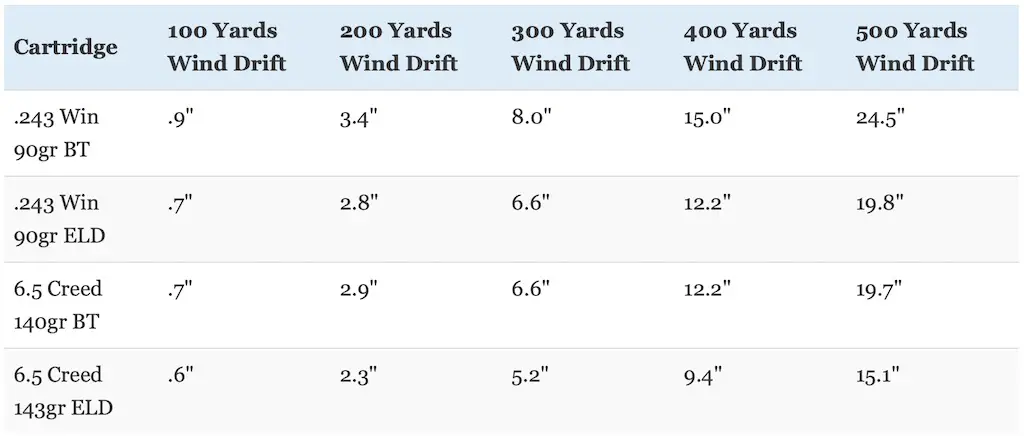
As you can see, the 6.5 Creedmoor has more resistance to wind drift than the .243 Winchester. Even though they’re going really fast, those lighter and less aerodynamic bullets used by the .243 just get pushed around a little more than the 6.5 Creedmoor.
The best .243 Winchester load has almost exactly the same amount of wind drift as the 6.5 Creedmoor load with the most wind drift, but the best 6.5 Creedmoor load drifts nearly 5″ less than the best .243 Winchester load and a staggering 9.4″ less than the .243 Winchester load with the most drift.
The differences are of course smaller at shorter range, but that’s a pretty big advantage in favor of the 6.5 Creedmoor at longer range.
That performance does come at a cost in terms of recoil though.
The table below compares the recoil produced by very similar loads to the ones compared above for each cartridge when fired from identical rifles.
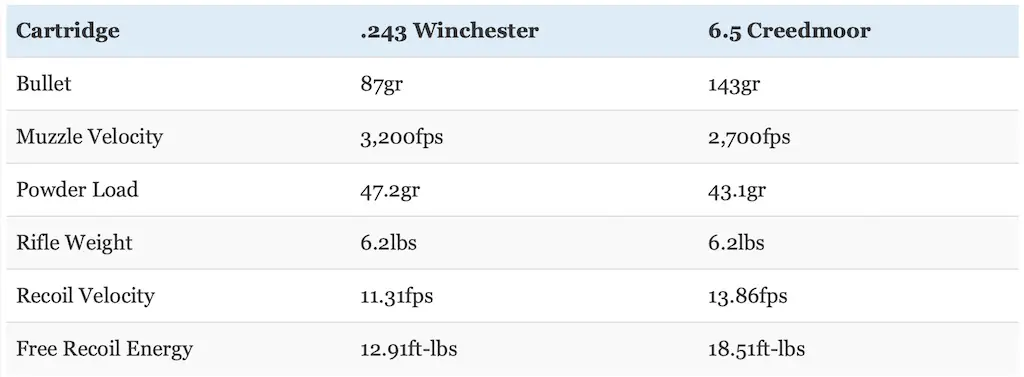
Felt recoil will vary from shooter to shooter and rifle to rifle, but free recoil energy is still a useful way to compare cartridges.
As you can see, the .243 Winchester has significantly less recoil than the 6.5 Creedmoor. In this case, the 6.5 Creedmoor has nearly 50% more free recoil energy than the .243 Winchester. That’s really saying something too because the 6.5 Creedmoor is known for pretty mild recoil itself.
Most shooters should be able to handle the recoil of both cartridges, but the .243 Winchester REALLY has the edge in this respect, especially for smaller or recoil shy hunters.
Don’t underestimate the impact that recoil has on the ability of a person to shoot accurately either. Some people do handle recoil better than others, but all other things being equal, they will absolutely shoot more accurately with a milder recoiling cartridge.
So where do we stand with each cartridge?
6.5 Creedmoor vs 243
The .243 Winchester fires smaller diameter bullets at a significantly higher velocity than the 6.5 Creedmoor. The .243 has a flatter trajectory and much less recoil, but the 6.5 Creedmoor retains more kinetic energy and drifts less in the wind than the .243 Winchester at typical hunting ranges.
All things considered, the two cartridges have different strengths and are optimized for different uses. The .243 Winchester has definite advantages in velocity, recoil, and trajectory while the 6.5 Creedmoor is more resistant to wind drift and carries significantly more energy downrange.
Additionally, the 6.5 Creedmoor has a couple of other advantages that are also worth discussing.
First, the 6.5 Creedmoor uses larger diameter bullets than the .243 Winchester.
Specifically, the larger diameter .264″ bullets used by the 6.5 Creedmoor have about 17% more frontal surface area (also known as cross sectional area) than the .243″ bullets used by the .243 Winchester (.0547 vs .0464 square inches). All other things being equal, a bigger bullet will make a bigger hole, cause more tissue damage, and result in more blood loss.
Especially when combined with the fact that the 6.5 Creedmoor carries more kinetic energy downrange than the .243 Winchester, those larger diameter bullets are certainly helpful when hunting big game.
The 6.5mm bore diameter is also in something of a sweet spot where it’s easier to manufacture very high BC bullets that’s aren’t especially heavy. Those aerodynamic projectiles don’t slow down as fast and are more resistant to wind drift.
At the same time, the 6.5 Creedmoor also has a slight edge over the .243 in bullet sectional density, especially with heavier bullets.
Sectional density (SD) is a measure of the ratio of the diameter of a projectile to its mass. All other things equal, a heavier projectile of a given caliber will be longer and therefore have a higher sectional density and consequently penetrate deeper than projectiles with a lower mass and sectional density.
As an example, 120 grain and 143 grain .264″ bullets have sectional densities of .246 and .293 respectively. This compares favorably to 90 grain and 100 grain .243″ bullets which have sectional densities of .218 and .242 respectively.
So, the high SD bullets used by the 6.5 Creedmoor assist with penetration to help the cartridge “punch above its weight” in a manner similar to the 7x57mm or 9.3x62mm Mauser cartridges.
What about 6.5 Creedmoor vs 243 accuracy?
The .243 Winchester is certainly capable of outstanding accuracy (often sub-MOA) and the exceptionally mild recoil of the cartridge also helps immensely in that regard.
At shorter range, the cartridges are very evenly matched. The .243 Winchester likely has a small advantage due to the fact that the mild recoil and flatter trajectory of the cartridge no doubt help hunters place their shots in the right spot to a greater extent than the 6.5 Creedmoor.
Yes, I know I’m splitting hairs here.
The situation changes a little bit when shooting at long distances though.
After all, the 6.5 Creedmoor was specifically designed as a competition shooting cartridge. At the same time, since it utilizes .264″ bullets, there is a bigger selection of high BC and high SD match grade hunting bullets available for the cartridge. Those factors give the 6.5 Creedmoor an edge at longer range where resistance to wind drift becomes more important.
That’s not to say that the .243 isn’t accurate or that there aren’t a bunch of good quality bullets available for it. It’s just that the overall design of the 6.5 Creedmoor gives that cartridge an edge over the .243 Winchester in potential accuracy at extended range.
.243 Winchester vs 6.5 Creedmoor Ammo
The .243 Winchester and the 6.5 Creedmoor are both extremely popular centerfire rifle cartridges. Indeed, they’re usually among the top 10 most popular cartridges in the USA each year right now. The 6.5 Creedmoor is a little more popular than the .243 Winchester, but they’re both widely used and ammo is easy to find for both.
The big ammunition manufacturers like Barnes, Browning, Federal Premium, Hornady, Nosler, Remington, Sierra, Swift, and Winchester all produce a large variety of quality .243 Winchester and 6.5 Creedmoor factory ammunition suitable for hunting most species. In each case, there is normally a good selection of bullet types and weights for each cartridge suitable for big game hunting.
Predator and varmint rounds like the Hornady V-Max and Nosler Varmageddon are also commonly available for both cartridges as factory loads, but they’re a little more common for the .243 Winchester.
During normal times, it’s usually very easy to find ammo for both cartridges and almost any gun or sporting goods store will have a wide variety of .243 Winchester and 6.5 Creedmoor ammo in stock.
Ammo availability is also usually excellent online and the bigger retailers typically have a good selection of quality factory ammo for both cartridges as well.
BUY SOME EXCELLENT 243 WINCHESTER HUNTING AMMO HERE
BUY SOME GREAT 6.5 CREEDMOOR HUNTING AMMO HERE
If you’d like to learn more about some of the various hunting ammunition choices for the .243 Winchester and 6.5 Creedmoor, read these articles:
Best 243 Ammo For Hunting Deer, Hogs, And Varmints
Best 6.5 Creedmoor Ammo For Hunting Elk, Deer, And Other Big Game
Handloaders will appreciate the fact that reloading components for both cartridges are also widely available and there’s an especially wide variety of bullet choices for each cartridge. So, you should not have any trouble working up a good custom load for either one if you like to handload.
The .243 Winchester uses the same 6mm/.243″ bullet size as the 6mm Remington, the .240 Weatherby Magnum, and the 6mm Creedmoor.
The 6.5 Creedmoor shoots the same .264″ bullet size that’s also used by the 6.5×55 Swede, 6.5 Grendel, .260 Rem, and 6.5 PRC (among others).
Bullets like the Barnes LRX, TSX, TTSX, and TAC-X, the Berger VLD, the Hornady A-Max, ELD-X, GMX, InterBond, InterLock, SST, and V-Max, the Nosler AccuBond, Ballistic Tip, E-Tip, and Partition, the Sierra GameChanger and GameKing, and the Swift Scirocco and A-Frame (just to name a few) are options for if you want to reload the .243 Winchester and the 6.5 Creedmoor.

243 vs 6.5 Creedmoor Rifles
In addition to the great selection of ammunition available in .243 Winchester and 6.5 Creedmoor, there are also many quality rifles manufactured in these cartridges. Just like with ammunition, 6.5 Creedmoor rifles are a little more common than .243 rifles. Both are extremely common though, so finding a good deer rifle shouldn’t be an issue at all regardless of which cartridge you choose.
Both cartridges are extremely common in bolt-action rifles. In fact, just about every really popular bolt-action hunting rifle in current production is available in both cartridges.
For instance, both the .243 Winchester and 6.5 Creedmoor are available in several different versions of the Remington Model 700 and Winchester Model 70. The same goes for the Browning X-Bolt, Kimber Hunter, Mossberg Patriot, Nosler M48, Remington Model 7, Ruger American, Ruger Hawkeye, Savage Axis, Savage 110, Tikka T3x, Weatherby Vanguard, and Winchester XPR.
BUY A GREAT 243 WINCHESTER HUNTING RIFLE HERE
BUY AN OUTSTANDING 6.5 CREEDMOOR HUNTING RIFLE HERE
Read the article below if you’d like to learn more details about some of the various hunting rifle choices for the 6.5 Creedmoor.
Best 6.5 Creedmoor Rifles For Hunting – Ultimate Guide
6.5 Creedmoor vs 243: Which Is Right For You?
Do you primarily hunt medium sized game like whitetail deer, feral hogs, or black bear at ranges within 200 yards? The .243 Winchester and the 6.5 Creedmoor are both absolutely outstanding deer hunting cartridges and both cartridges will absolutely get the job done on medium sized game if you do your part and there isn’t a gigantic difference between them ballistically inside of 300 yards. Go with the .243 if you’ll be primarily hunting game like deer or the 6.5 Creedmoor if you want something a little more versatile.
Are you looking for a the better cartridge for long range hunting for game like mule deer or pronghorn in open country where you might need to take a shot at several hundred yards? The .243 will work for this sort of hunting, but the 6.5 Creedmoor is the better choice here because it’s more resistant to wind drift and carries a more energy out past 200 yards.
For example, I hunted pronghorn in Colorado back in 2022. My guide told me he’d seen well over 100 pronghorn get shot over the course of his 40+ year guiding and personal hunting career. He used a 243 for those hunts for a long time, but switched over to the 6.5 Creedmoor after seeing a couple of his clients use it with so much success.
In fact, he told me he thought the 6.5 Creedmoor was the best cartridge for hunting pronghorn when I told him that was what I was using. And yes, I ended up taking a nice buck on that hunt using a 143gr ELD-X.

Do you want a hunting cartridge that’s well suited for caribou, moose, elk, eland, kudu, or red stag hunting? I consider both to be on the light side for hunting larger game, but the 6.5 Creedmoor is definitely better than the .243 Winchester for this sort of hunting because it shoots larger diameter bullets that carry more kinetic energy downrange, especially with heavy bullets.
So yes, you can hunt elk with the 6.5 Creedmoor, but you need to be aware of a couple of things before you go down that road though.
To that end, I recorded an entire podcast episode on elk hunting with the 6.5 Creedmoor with someone who has cleanly taken elk with the cartridge. Our discussion does a great job of covering the pros and cons of the 6.5 Creedmoor for elk hunting and anyone planning on going elk hunting in the future should definitely listen to this interview.
Just click the appropriate link below to listen to this episode on your preferred podcasting service. Be sure to hit that “subscribe” or “follow” button if you like the show!
6.5 Creedmoor For Elk Hunting Podcast
Apple | Google | iHeart | Spotify
Are you sensitive to recoil and in need of a serious low recoil cartridge? The .243 Winchester has significantly less recoil than the 6.5 Creedmoor, especially in a lighter rifle. This cartridge is especially well suited to new, small framed, and or recoil shy hunters. Indeed, the .243 Winchester is extremely popular for children to use for deer hunting because it is so effective on deer and has such mild recoil. For this reason, a good rifle chambered in .243 Winchester is a great gift for a hunter who is just getting started.
Do you want the round that is best suited for target shooting out past 400 yards or so in a precision rifle? The 6.5 Creedmoor is significantly better for work at longer ranges since it is specifically designed to use very high BC bullets, but still has manageable recoil. It is hands down the best choice for long range shooting of the two cartridges.
The .243 Winchester and 6.5 Creedmoor are both excellent rifle cartridges, albeit ones with very different strengths and weaknesses. Though the differences between them (6.5 Creedmoor vs 243) are significant in some respects, they’re both suitable for many hunting tasks. Get a good hunting rifle chambered in the cartridge that you think fits your needs the best, learn to shoot it well, use quality bullets, and you’ll be all set for most hunting situations. Good luck!
NEXT: 6.5 CREEDMOOR vs 300 WIN MAG REVIEW AND COMPARISON
Enjoy this article comparing the .243 Winchester and 6.5 Creedmoor cartridges? Please share it with your friends on Facebook and Twitter.
The Lyman 50th Edition (p159-162, 183-184) and Hornady 10th Edition (p231-237, 317-322) reloading manuals were used as references for the history of the cartridges. I obtained the data used to compare the trajectory of the cartridges from Hornady (here and here) and Nosler (here and here). Data used to calculate recoil was obtained from the Hornady reloading manual. Case capacities were obtained from Chuck Hawks (here and here). Maximum pressure obtained from SAAMI (p23 & 26). I used ShootersCalculator.com to compare trajectory and recoil for the cartridges.
Make sure you follow The Big Game Hunting Blog on Facebook, Instagram, Twitter, and YouTube.
NEXT: 308 vs 30-06 SPRINGFIELD vs 300 WIN MAG: WHICH SHOULD YOU HUNT WITH?
John McAdams is a proficient blogger, experienced shooter, and long time hunter who has pursued big game in 8 different countries on 3 separate continents. John graduated from the United States Military Academy at West Point and is a veteran of combat tours with the US Army in Iraq & Afghanistan. In addition to founding and writing for The Big Game Hunting Blog, John has written for outdoor publications like Bear Hunting Magazine, The Texas State Rifle Association newsletter, Texas Wildlife Magazine, & Wide Open Spaces. Learn more about John here, read some of John’s most popular articles, and be sure to subscribe to his show: the Big Game Hunting Podcast.

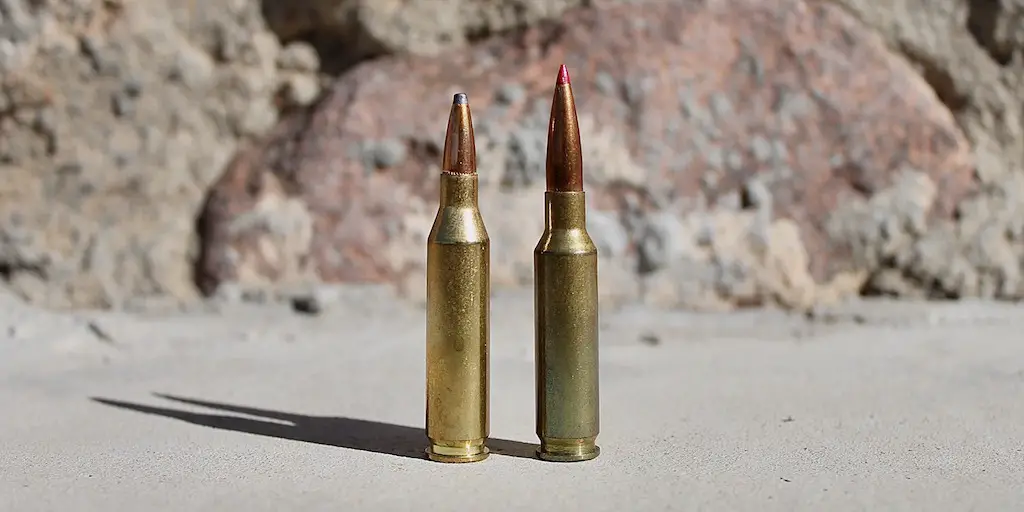

thanks!!!
Nice job. You answered my questions. My .243 single shot is a tack driver with 70gr bullets, but the groups widen dramatically with deer hunting weights (90-110gr). I was considering 6.5 Creedmoor as an alternate deer and antelope hunting cartridge, and your article gave me exactly the information I needed. Thank you, Russ.
Tendrías que cambiar tu caño a un caño con un twist de 1-8 para poder usar bullet de 105 a 115 grains con buena precisión..
“By modifying a .30 Thompson Center (.30 TC) case to shoot .264″ bullets, they successfully built a cartridge with a relatively large case capacity optimized for use with 4350 class propellants that could also accommodate long, heavy, high ballistic coefficient (BC) bullets without intruding into the powder column.”
Is this a typo, or am I misinformed? 6.5 creedmoor’s parent case is a .308 Winchester. 6.8 SPC’s parent case is the .30 TC.
The 6.5 Creedmoor’s parent case is indeed the 30 TC, NOT the 308. The 6.8 SPC’s parent case is the old .30 Remington.
Thank you for the article, but I don’t think it’s a fair comparison when the 6.5 bullets are 50 – 53 grains heavier.
Hi Mike. Thanks for your comment. I hear what you’re saying, but this is how you compare cartridges of different bore sizes like the 243 and 6.5 Creedmoor. It’s almost impossible to only compare the two cartridges using the same bullet weights because the very heaviest bullets for the 243 are barely as heavy as the very lightest bullets available for the 6.5 Creedmoor. With this in mind, the best way to compare the two cartridges is to do so using the exact same type of bullet for each cartridge (like the ELD-X and ballistic tip bullets I used here) in a factory load. Hope this makes sense.
Do you have any comparisons of the 6.5 and the 270 Winchester?